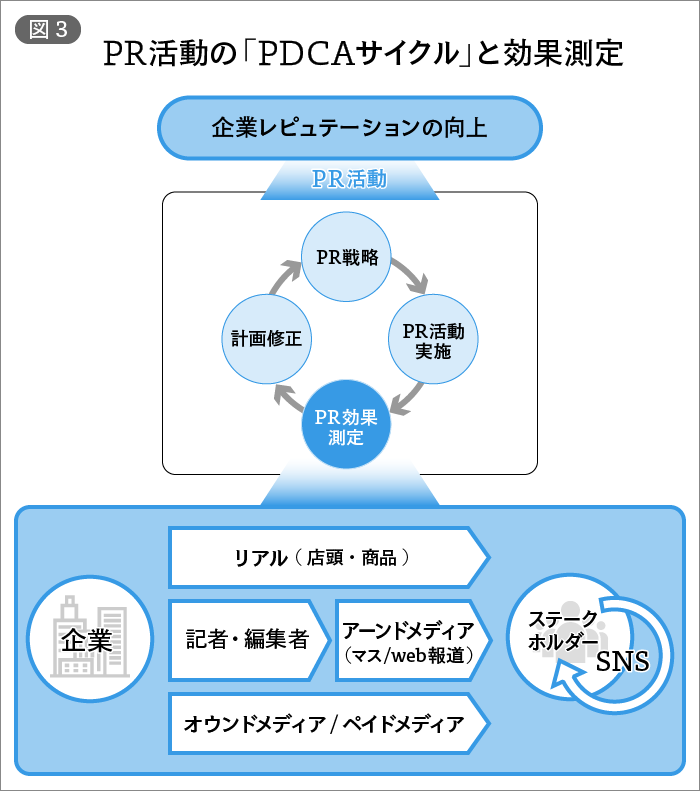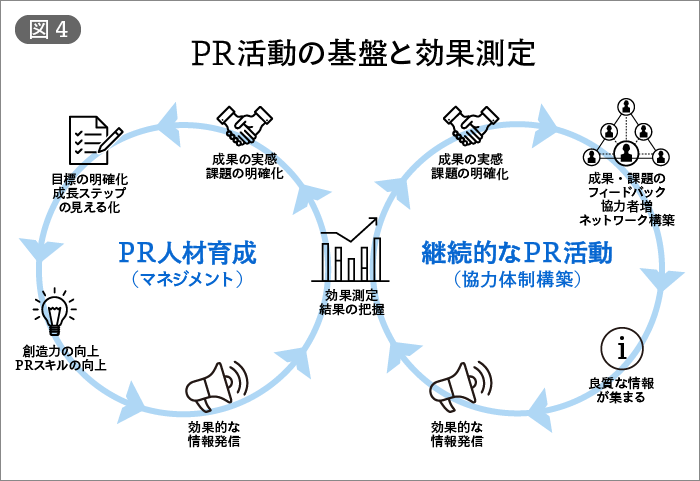Note: This website was automatically translated, so some terms or nuances may not be completely accurate.
PR Effect Measurement and Data-Driven PR
Many companies cite enhancing reputation, recognition, and brand power—which also constitute corporate value—as the purpose of their PR activities. To conduct effective PR, it's essential to work backward from these objectives when planning PR activities for various corporate initiatives, such as new product launches or business partnerships, strategically building the PR plan accordingly.
Strategic PR planning begins with researching the social environment and market. Then, a PR strategy is devised and executed based on that situation. The effectiveness is measured, the continuation of the activity itself is evaluated, and adjustments are made as necessary—repeating this cycle multiple times. Since PR strategy is fundamental to management, its impact must always be measured; effectiveness measurement is indispensable.
Therefore, in this series, we will discuss effectiveness measurement in data-driven PR (PR based on data obtained from research) from various perspectives.
Current State and Challenges of Effectiveness Measurement in PR Activities
According to a survey by the Corporate Communications Strategy Research Institute, Dentsu Inc.'s research organization (Figure 1), while 84.7% of companies (n=518) measured effectiveness in the most recent 2018 data, the metrics used were remarkably diverse. These included "number and volume of newspaper and magazine articles," "number of visits to the company website," and many other items.
This diversity suggests that companies are struggling to find optimal effectiveness measurement. So why are so many companies struggling?

Three major factors can be considered (Figure 2).

First, "the definition of PR effectiveness is unclear." When it comes to measuring effectiveness, the mainstream approach focuses on metrics like media exposure results, often converted into advertising cost equivalents. However, the global trend in evaluating PR outcomes is shifting from output metrics (e.g., how much information was exposed) to outcomes metrics (e.g., inquiries about products/services, sales figures, or attendance at recruitment events) – measuring what impact the exposed information actually generates.
However, outcomes are the result of various intertwined factors, making it extremely difficult to isolate the results solely attributable to PR activities.
The second challenge is the "diversification of media used for PR activities." Companies are increasingly required to engage with a broader range of media, expanding beyond the traditional focus on earned media (like publicity and analyst reports) and paid media (like advertising) to include owned media (such as websites), shared media (like widespread social media and word-of-mouth), and more.
Beyond the difficulty of allocating resources to each medium, many companies struggle to evaluate the results of these distinct media types uniformly, even when focusing solely on outputs.
The third challenge is the "need for continuous baseline monitoring." It is difficult to verify the effectiveness of initiatives based on single-year figures. To capture changes before and after implementation or track activity over time, companies need to secure a certain level of budget annually. This is also likely challenging for many companies.
The Effectiveness and Importance of Effect Measurement
However, it is risky to conclude that effect measurement can be "put off" or even "omitted." Rather, effect measurement is expected to generate the following highly significant benefits during PR activities:
First, it facilitates the smooth operation of the PR activity's PDCA cycle (Figure 3).

Effect measurement corresponds to the "C" (Check) in PDCA. Without this process, it becomes impossible to determine whether PR activities are achieving the intended effects relative to management goals. For example, without knowing not only the "degree of exposure" (output), but also "how journalists perceived it" and "how stakeholders who saw the articles or programs felt," it is impossible to understand what kind of reputation has been formed.
Consequently, you cannot evaluate your current strategy, making it impossible to maintain or enhance reputation. This could ultimately lead to a decline in corporate value itself.
Second, PR activities also create a foundation. This foundation consists of "developing personnel responsible for PR activities" and "building internal cooperation systems" (Figure 4).

To achieve results from PR activities, developing the personnel responsible for these activities is essential. Activities should be conducted based on goals and individual growth steps for the personnel. The results should be captured through effectiveness measurement, then linked to the next steps and improvement of individual challenges. Creating a cycle where those involved enhance their skills enables the organization to improve as well.
Furthermore, "building an internal collaborative framework" is crucial as it provides essential material for high-quality information dissemination. After receiving cooperation for information dissemination, providing feedback to contributors and departments on how the information was utilized and the resulting outcomes helps establish a sustainable collaborative framework.
To continuously invest resources in PR activities, strengthen PR functions, build a foundation, and achieve results, it is necessary to measure effectiveness and fulfill accountability.
What to Measure in Effectiveness Evaluation: The Reality of PR Effectiveness Measurement
To conclude this article, we will briefly touch on the survey methods available to address the challenges of PR effectiveness measurement: the "need for continuous fixed-point observation" and the "diversification of media utilized for PR activities," which are essential for understanding the state of PR efforts.
・Reach-Point Survey
Measures exposure volume across news and social media in terms of reachable audience size. It reveals the scale of reach, peaks, and temporal changes per media outlet resulting from PR initiatives. This enables unified evaluation and effectiveness verification of diverse strategies and serves as a KPI for PR activities.
・News Media Survey
This survey aids in understanding media landscapes from various angles. It includes: - Media Coverage Analysis: Quantitatively analyzes coverage results by media outlet using metrics like reach and number of articles. - Tone Analysis: Qualitatively compares and analyzes the editorial stance of each media outlet's coverage. - Media Interviews: Gathers insights into the perceptions, knowledge, and perspectives of journalists writing articles through direct interviews.
・Social Listening
The influence of shared media, such as social media and word-of-mouth, continues to grow annually. In particular, the concise tweets posted by consumers on Twitter often reveal their true feelings, making it an ideal tool for gauging reactions and the spread of messages. Social listening is the research method used to analyze this. It also offers the advantage of quickly securing a large sample size.
・Targeted Surveys
Primarily conducted via web surveys, this focuses on specific demographics (age, occupation, etc.) or individuals exhibiting particular behaviors/responses to capture reactions not fully captured by social listening.
・Attractiveness Branding Survey
This survey has been conducted since 2016 by the Corporate Communications Strategy Institute, Dentsu Inc. Public Relations' research organization. The Corporate Appeal Survey is a methodology that expresses the appeal consumers feel toward companies across three appeal domains (human, financial, product) and 18 areas. By comparing results with those of 150 companies, it helps identify the strengths and weaknesses of a company's PR activities, enabling the review of strategies and organizational structures.
Survey Examples
・Corporate PR Capability Survey
This survey has been conducted by the Corporate Communications Strategy Research Institute since 2014. Based on the "PR Octopus Model," which classifies required corporate communications activities into eight categories and 80 items, the survey is conducted biennially targeting PR managers of listed companies in Japan. It analyzes the strengths and weaknesses of a company's PR capabilities compared to industry averages.
Survey Examples
Identifying Gaps Through Clarifying Objectives
Thus far, we have introduced the current state and challenges of measuring PR activity effectiveness, along with specific methodologies. However, the most crucial aspect of PR activities is not the measurement itself, but rather clarifying the purpose: "Why are we conducting PR activities?" Needless to say, this is followed by planning and executing measures aligned with that purpose.
The purpose of improving reputation through PR—whether contributing to sales, supporting recruitment efforts, or other goals—varies by company. Implementing every conceivable measure is unrealistic due to budget and personnel resource constraints.
Therefore, it is essential to verify effectiveness each time, assess how to bridge the gap with the goals, determine priorities, confirm alignment between initiatives and societal needs, and make decisions regarding plan revisions, initiative adjustments, and whether to continue.
To drive this PDCA cycle and execute effective PR activities, measuring effectiveness—the "C" in current status assessment—is particularly crucial.
When the purpose of PR activities and the function of each measure are clearly defined, the measurement items and numerical targets naturally become clear as well. When planning and implementing effectiveness measurement, we hope this article serves as a useful reference for conducting "effective" effectiveness measurement that firmly returns to the core purpose of PR activities and forms the foundation of those activities.
Was this article helpful?
Newsletter registration is here
We select and publish important news every day
For inquiries about this article
Author

Shigeru Sakai
PR Consulting Dentsu Inc.
Corporate Communications Strategy Bureau
Director, Corporate Communications Strategy Research Institute Senior Researcher
At a research firm, primarily engaged in marketing research for new product and service development. At a publishing company, handled planning, analysis, and presentation of advertising effectiveness measurement and surveys on youth attitudes and lifestyles. After joining Dentsu Inc. Public Relations, engaged in strategic planning for corporate communications, particularly strategic PR activities leveraging research expertise. Assumed current position in 2015. Engaged in planning and consulting centered on research within the corporate communications domain.
